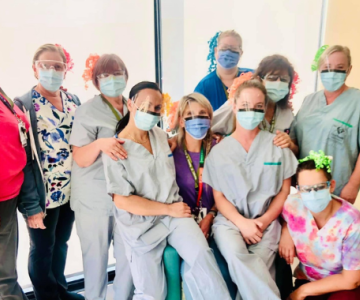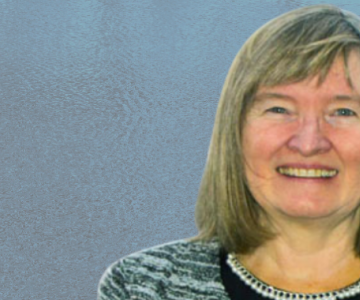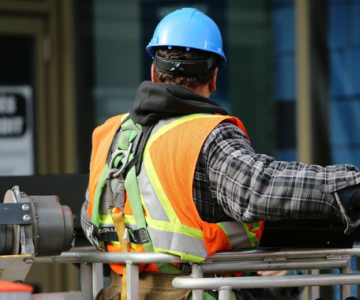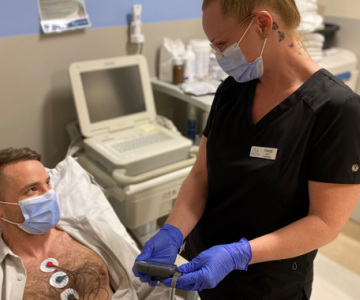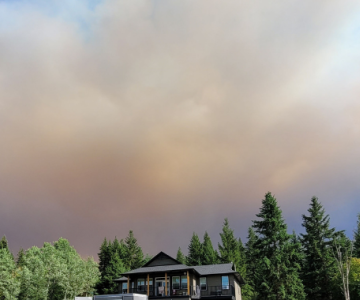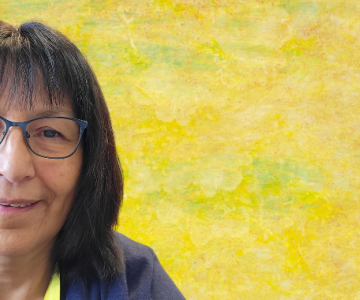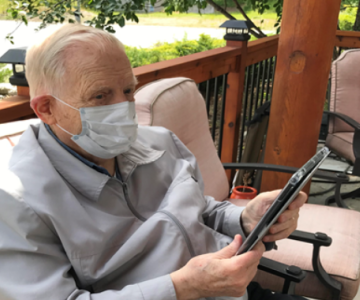Breadcrumb
Explore Stories
Community & Culture
Brookhaven's Chronic Behavioural Disorder unit staff celebrate a resident's 80th birthday while evacuated at Creekstone Manor in North Vancouver in August 2021.
In August 2021, the Brookhaven Care Centre team in West Kelowna came together in extraordinary measures to safely evacuate all 104 of their residents from the risk of wildfire.
Residents boarded a series of buses, then an airplane, to arrive at their destinations in Vancouver. Several staff accompanied the residents on the journey, a few working continuously for 24 hours to ensure everyone was safe and settled into their temporary homes. One dedicated health-care aide even slept on the floor of the nursing unit the first night, keeping close by in case his residents needed him.
Pam Gill, LPN (left) and Keegan Dufresne, Long-Term Care Aide
A number of team members continued to live on-site with the residents, while others travelled back and forth between the Interior and the coast for a number of weeks. The efforts staff put in to make the best of the experience were incredible. They took time to decorate the residents’ bedrooms with posters and comfort items, and even hosted an 80th birthday party and 60th wedding anniversary celebration. These staff gave all their love and attention to their residents while being separated from their own homes and families.
The staff who stayed behind were no less dedicated, taking great care in cleaning the site top to bottom and preparing everything for the happy return of their residents.
A triumphant return for Brookhaven Care Centre staff member Tana (top) and resident Mary.
“I am constantly inspired by the incredible team that we have at Brookhaven, and how much they genuinely care about their residents,” said Renee Gauthier, Manager, Clinical Operations.
“It is because of their compassion and dedication that our vulnerable seniors were kept safe from greater distress during this emergency situation. While there were bumps and lessons learned, the competence, collaboration and humour of this team was commendable at every step of the way. I am so very proud of them!”
Renee Gauthier, Manager, Clinical Operations, Brookhaven Care Centre is constantly inspired by the Brookhaven team.
Natural Disaster Champions series
In 2021, the B.C. Interior region experienced a natural disaster season like none other. Interior Health staff stepped up and came together to support each other, patients, friends, family and communities. We’re sharing the stories of staff members reflecting on how being prepared – at home and at work – can make all the difference when minutes matter.
View more stories in the series
Community & Culture
More than 50 years ago, police raided the Stonewall Inn, and demanded sex verification checks on the patrons. A spontaneous protest broke out that helped to spread the conversation about lesbian, gay, bisexual, transgender, queer and/or questioning, intersex, asexual, and Two-Spirit people (LGBTQIA2S+) issues and the battle for acceptance and inclusion. It was also the start of what today we celebrate as Pride.
Pride is an opportunity to recognize the impact of lesbian, gay, bisexual, transgender, queer and/or questioning, intersex, asexual, and Two-Spirit people in our communities.
Become an ally to contribute to the elimination of racism and discrimination. An ally is someone who:
Addresses the issue, not just the incident
Is willing to take risks and speak up
Is visible, active, vigilant, and public (even when the target person is not in the room)
Is willing to recognize the inherent privilege and power of being a member of the dominant group
Views their own membership in the dominant group as an opportunity to bring about change
Is proactive more often than reactive
Is always intentional, overt, vocal, consistent, and public about being an ally (allies aren't silent)
Join us in celebrating Pride, not only this month, but throughout the year - as allies with LGBTQIA2S+ people everywhere.
Learn more:
Being an LGBTQ2+ Ally (Government of Canada School of Public Service
Commemorate 50 Inclusivity Toolkit (Government House of BC)
Canadian Centre for Diversity and Inclusion
The Arquives: Canada’s LGBTQ2+ Archives
Community & Culture
Name: Dr. Sue MacDonaldJob Title: Executive Medical DirectorYears of Service: 7Worksite: Kelowna Community Health CentreCommunity: KelownaAncestral Territory: Syilx
Later this summer, Dr. Sue MacDonald will retire from her role as Executive Medical Director with Interior Health. IH Aboriginal Partnerships recently recognized Dr. MacDonald for her ongoing commitment and medical leadership in support of improving Aboriginal Health outcomes and access to culturally safe care.
Research & Innovation
When you think about diversity and inclusion, do you consider age?
Research shows that age is often missing in the diversity and inclusion conversation. Yet our unconscious biases, thoughts, feelings and actions about aging have direct consequences for young and old alike.
“Ageism is when age is used to categorize people in a way that results in harm, or being disadvantaged. It can also occur when age is used to divide people and injustice occurs, such as when institutional policies or practices perpetuate the stereotypes or beliefs about aging,” says Shannon Paul-Jost, a clinical nurse specialist in gerontology.
For example, according to the World Health Organization (WHO), older adults in the workplace are disadvantaged when they try to access specialized training and education. Ageism towards younger individuals is also apparent in areas such as employment, health, housing, and politics, where the youth voice is often denied or dismissed.
For older adults, the impacts of ageism have wide-ranging consequences and is "associated with poorer physical and mental health, increased social isolation and loneliness, greater financial insecurity, decreased quality of life and premature death," according to a report from the WHO.
To combat ageism, there are several strategies that can reduce prejudice and improve thoughts, feelings and actions towards aging:
Creating educational activities that focus on building empathy, creating compassion and dispelling misconceptions, to support people at any age;
Being strategic with planning and ensuring events and activities are intergenerational to promote well-being and reduce stereotypes;
Developing organizational practices and policies that do not categorize people by age; and
Supporting legislation that addresses ageism.
Learn more:
Forbes article The One Critical Element Missing From 92% Of Diversity And Inclusion Strategies
WHO global report on ageism
WHO Start conversations about ageism
Ageism Infographic
CANage: Stop the Stigma Key Learnings
Community & Culture
More than 9,000 British Columbians have died due to the toxic drug poisoning since 2016 – with 2021 being the worst year on record at 2,224 deaths. According to the BC Coroners Service, four in five people who die are men, and approximately one in five have worked in trades, transport and equipment operation.
With those statistics fresh in mind, the B.C. construction industry decided to take a hard look at the reasons why men in their industry were dying from overdose. They asked their tradespeople, and what they heard back spurred the creation of the Tailgate Toolkit, a program aimed at increasing access to harm reduction services and support for those working in the construction industry.
Access the Tailgate Toolkit
The Tailgate Toolkit is a partnership between the Vancouver Island, Vancouver, Southern Interior, and Northern construction associations.
Christina Cole, the Southern Interior Construction Association’s harm reduction coordinator, says providing resources for people who work in their industry is like providing another level of safety for people who may be seeking relief and using substances, she says.
“In construction we have personal protective equipment like hard hats and safety glasses, fall protection and if anything happens, there is first aid on the site,” says Christina. “We need to take that lens and bring it to substance use.”
When the provincial construction associations surveyed their members about toxic drug use, the responses ranged from heightened expectations of masculinity and toughness, to workplace culture, to feeling undervalued and exhaustion. And there was reference of pain management – which isn’t entirely surprising, given the BC Coroners Service notes that two in five people had contact with health services in the year prior to their death for pain-related issues.
“As I got a little bit older … You know my body’s kind of starting to feel a little more aches and pains … Of course, the opiates would really help with that,” said one respondent.
“Well, the benefits (of cocaine) were extreme energy,” said another. “Yeah, just gave me that boost I needed to get through that last, you know, few hours of the day or the few hours left on the Friday after a long week. That’s what it did to me, it gave me the boost I needed, the energy to perform my job … fatigue is huge.”
Said a third: “It was just really hard work, and pretty much everyone that I worked there (with) went out to the bar afterwards and drank and the coke came out. … It was almost like a lifestyle, right? You work hard and then you play hard.”
Interior Health is also paying attention to the harm reduction principles presented in the Tailgate Toolkit. Project managers from IH’s Capital Planning & Projects team recently took in a presentation on the toolkit. The team manages contractors and consultants on close to 100 active capital projects; their attention to the risks and strategies associated with harm reduction will seek to reduce stigma and support those who may be struggling.
“Our teams interact with contractors and consultants from the construction industry on a regular basis,” said Michael Morton, Senior Project Manager, Interior Health Capital Planning & Projects. “The Tailgate Toolkit will help us support those in our industry who may be struggling with substance use issues and in need of support. We fully support the principles behind this important initiative.”
Health & Wellness
One never expects to have heart issues at the age of 27 – but for Samantha O’Callaghan, it’s a reality. Samantha was diagnosed with third-degree heart block, for which she now has a dual chamber pacemaker, but also Supraventricular tachycardia (SVT), which requires cardiac ablation.
Samantha is delighted to hear that Interior Health is upgrading heart monitors across the region, improving patient access to important diagnostic testing, and enhancing timely access for physicians and nurse practitioners to these reports.
“I couldn’t be happier to hear about the Holter monitor upgrade project across Interior Health,” said Samantha. “Being 27 years old with unstable chronic arrhythmias, the importance of evolving and up-to-date technology is of utmost importance to my long-term care. I couldn’t be more grateful for the increase of my quality of life that Holter monitors have brought with their help in diagnosing and ultimately treating my chronic heart condition.”
Samantha O’Callaghan is excited for the region-wide heart monitor upgrade.
A heart (or Holter) monitor is a diagnostic test that monitors cardiac rhythms via continuous electrocardiogram (ECG) tracing over 24 hours or more. For patients, the brand new devices and system will prevent diagnostic cancellation or the need for diagnostics due to equipment issues. The consistency of the new technology also ensures that the scanning of Holter exams can be done by clinicians across IH, meaning people can get their results faster than with the previous system.
This project is the outcome of the collaborative efforts between IH and the Royal Inland Hospital (RIH) Foundation. The project came to fruition because of a generous estate gift from Bill and Catherina Humphrey.
“The Royal Inland Hospital Foundation is proud to take care of our big family at Interior Health. The impact of this legacy donation is greater than we could have ever wished for,” explained Heidi Coleman, CEO of the RIH Foundation.
The phased roll-out, which includes 31 sites across Interior Health, began in March and will be complete by the end of June.
Community & Culture
The White Rock Lake wildfire, located approximately 34 kilometres northwest of Vernon, ignited on July 13, 2021. For about two weeks, residents of Monte Lake, the Paxton Valley, Westwold and Falkland remained on high alert as this fire rumbled around, refusing to be suppressed.
Then on Aug. 5, sustained winds of 25 km/hr gusting to 40 km/hr from the southwest blew the fire rapidly to the northeast and east, impacting hydro and transportation infrastructure, and threatening communities. Multiple structures were lost in the Monte Lake area during the fire’s 15 km run.
Deb, administrative assistant and Pritchard resident, was working on Interior Health’s wildfire Incident Command when she heard the news and prepared for possible evacuation. Outside looking towards Paxton Valley, the sky was angry with brown and black plumes of smoke, the fire maybe 7 km away.
Having lived through the previous year’s wildfire season, Deb knew what it felt like to be on high alert. The proximity of the White Rock Lake wildfire was a trigger, which spurred Deb in to action to be exceptionally prepared:
She moved her horse one week before and relocated the travel trailer to an RV park for August
The horse trailer came home and on standby to move other boxes, hooked up to the truck with a full tank of gas
She placed a list by the phone of emergency phone numbers and itemized items to help with departure
Boxes including passports, photos and other important papers sat ready for loading, and headlamps were accessible next to containers for nighttime departure
An overnight bag was packed with necessities, including prescriptions
Dog kennels were placed in the vehicle with their food, collars and leashes
Propane tanks, other vehicles and equipment were moved to an open area out front
Sprinklers sat on the roof, ready to go with large water tanks and a generator pump
A note was prepared for the window: All livestock, pets and humans are safe and removed
A grab-and-go bag is a small emergency kit that's easy to take with you, in case you need to leave right away. It's a good idea to make grab-and-go bags for your home, workplace and vehicle. Learn what supplies you should include in a grab-and-go bag.
“Some thoughtful planning ahead of this difficult day helped to make leaving a bit easier,” said Deb. “Luckily, our home was spared from the beast – the fire was stopped by the fire guard about a kilometre away.”
Natural Disaster Champions series
In 2021, the B.C. Interior region experienced a natural disaster season like none other. Interior Health staff stepped up and came together to support each other, patients, friends, family and communities. We’re sharing the stories of staff members reflecting on how being prepared – at home and at work – can make all the difference when minutes matter.
View more stories in the series
Community & Culture
Name: Jacqueline Mattice (she/her)Job Title: Aboriginal Patient Navigator Years of Service: 1Worksite: Cariboo Memorial HospitalCommunity: Williams LakeAncestral Territory: SecwépemcAdvice to live by: "If you are working on something exciting that you really care about, you don't have to be pushed. The vision pulls you." - Steve Jobs
Jacqueline Mattice was born in Lillooet and raised in the small community of Shalalth. She is one of eight children raised by the strength and dedication of her single mother. Jacqueline has a great sense of humour. She is kind, friendly and humble.
Her work with Elders as a human resource assistant led Jacqueline to apply to the social work program at Thompson Rivers University in Kamloops.
“I knew at that time I wanted to assist Aboriginal people,” she says. Jacqueline completed her fourth year practicum at Royal Inland Hospital with Aboriginal Patient Navigator Deb Donald. “She taught me so much in my three months at RIH.”
Jacqueline joined the Cariboo Memorial Hospital team as an Aboriginal Patient Navigator last June.
“From the first day [the team] made me feel welcome and everyone goes above and beyond when I need assistance,” she says.
Research & Innovation
The onset of COVID-19 brought many changes to family caregivers and service delivery. Many services shifted to online and virtual support, leaving some caregivers struggling to access this new platform due to lack of technology.
Recognizing this need, the Caregivers Network for East Kootenay Seniors, an agency partially funded by Interior Health, purchased 27 iPads. They delivered these iPads, along with cases and Apple pens, to clients in need throughout the East Kootenay.
Interior Health understands how the ability to keep people and their families connected is vital to mental and emotional health, and has been proactive in helping people and their caregivers receive these online tools to allow for ongoing therapeutic, virtual connections.
“This was a wonderful project and targeted a real need in our community. We were able to reach seniors and caregivers who were already extremely isolated and more so due to COVID 19,” says Executive Director Tobi Johnston. “One caregiver broke down and cried when she received her new tablet stating she had not left the house or spoken to anyone in days. Our staff spent countless hours teaching seniors and caregivers how to use FaceTime, how to download Zoom, and how to participate in our online support groups.
"We have even gone so far as to provide support in providing tutorials on how to call grandkids by video call. Through this project, family caregivers in our region have demonstrated their tenacity and ability to rise up and meet the challenges and changes in how support is offered. We are so proud of them and our community in staying connected and safe during these times.”
One of the people who benefited was caregiver Dave Dunbar. Donna Singer, Dave’s daughter, says giving her 88-year-old father the ability to visit their mother via FaceTime was invaluable.
“Our parents were separated early on in the (COVID-19) quarantine, as my mom went into hospital. Window visits proved to be frustrating as neither could hear the other through the two-inch window opening. As restrictions eased, he was be able to visit in-person at least once a week, but the FaceTime calls continued to be invaluable on days when visiting isn’t available. As well as talking with Mom, Dad has been able to see his kids, grandkids and great grandchildren via screen.
“Please let all involved people and organizations know how grateful Mr. Dunbar and his children are for the iPad provided for him to use from the Caregivers Network for East Kootenay Seniors Family and Interior Health for supporting this program.”
Through regional engagement with the Caregivers Network for East Kootenay Seniors, Dave was able to access the technology to remain connected to loved ones but also to participate in the Network’s caregiver support group online. By accessing this online virtual support group Dave not only found emotional support in his caregiving role but went on to become an advocate for other caregivers and seniors in the region to embrace technology and ask for help.
This example clearly demonstrates that as the nature of senior health care continues to grow in complexity, providing education, training, and emotional support and services is critical for the well being of caregivers and those they care for.
Reprinted with permission from Caregivers Network for East Kootenay Seniors
Learn more about the Caregivers Network for East Kootenay Seniors
-
Load More
Showing 450 of 786
Sign up for email updates
Receive news, alerts, public service announcements and articles right to your inbox.


